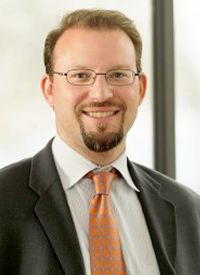Article
Cerdulatinib Shows Promise in Relapsed/Refractory NHL
Author(s):
Paul A. Hamlin, MD, discusses his research with cerdulatinib in patients with certain types of non-Hodgkin lymphoma.
Paul A. Hamlin, MD

Paul A. Hamlin, MD
The dual Syk-JAK inhibitor cerdulatinib is being evaluated in a phase II study of patients with relapsed/refractory B-cell malignancies, including chronic lymphocytic leukemia (CLL) and follicular lymphoma.
In his presentation at the 2017 European Hematology Association (EHA) Congress, lead researcher Paul A. Hamlin, MD, Chief of the Medical Oncology Service at Memorial Sloan Kettering Basking Ridge, discussed the initial results of this trial.
Early findings showed that 67% of patients with CLL achieved a response, as well as 56% of patients with follicular lymphoma.
OncLive: Could you provide some information on cerdulatinib?
What is the design of this study?
In an interview with OncLive at this year’s EHA congress, Hamlin discussed his research with cerdulatinib in patients with certain types of non-Hodgkin lymphoma.Hamlin: Cerdulatinib is a small molecule inhibitor, I think it is exciting in terms of the explosion in small molecule inhibitors that have been active and effective in the NHL space. We have many agents that are really helping our patients. This is a dual inhibitor, it is an ATP-competitive inhibitor of 2 pathways, the JAK-stat pathway, as well as the B-cell receptor pathway that ends in a NF-kappa B increased expression in terms of B-cell survival. The concept is that by duel inhibiting on parallel pathways where there is crosstalk, that we have the ability to augment the response in B-cell lymphomas.This is a phase I that went into a phase II study. It is an open-label phase II expansion that is driven by cohort, the cohorts are specifically CLL/small lymphocytic lymphoma (SLL), follicular and indolent lymphoma, and there is now a T-cell lymphoma cohort and there is an aggressive lymphoma cohort that is not currently accruing.
What results have been seen so far?
It is a 2-stage design, where if we see the activity that we expect, it goes on to accrue 20 to 40 patients within each cohort and we've already passed that first benchmark for both the CLL/SLL and the follicular and indolent lymphoma patients. To date, there have been 3 patients who have accrued with T-cell lymphoma, and the first patients had a response so that was encouraging.I think what we see are preliminary results. This is an oral agent that is very active, it is well tolerated, the dosing is twice daily and patients have been able to stay on drug with disease control and good quality of life. Now, at least 4 of them are approaching a year of continuous therapy.
For the patients that are evaluable, 50% of the patients have had a response, which have been predominantly partial remissions—they occur early, after about 2 cycles. In the CLL/SLL cohort there has been a 67% response rate out of about 18 patients treated so far. And in the follicular lymphoma cohort, 5 out of 9 patients—or 56%—have responded.
What are the next steps?
This is the clinical activity that we hoped for and expected given the biology. It has been gratifying that it’s been present. As I mentioned, the first T-cell lymphoma patient who went on this study actually had a complete remission after 2 cycles, so [there is] some proof of concept at least that the Syk pathway—which is not normally expressed in T cells but is aberrantly expressed in the T-cell lymphomas—is important.I think the next steps for this phase II study are really to, with greater confidence, define how effective it is in each of the disease cohorts. If the results hold up, it is certainly exciting as a single agent. The T-cell lymphoma cohort will be particularly exciting; our T-cell lymphoma patients are in desperate need of more options, and if we demonstrate activity there, I think there will be a lot of excitement.
Where do you think this inhibitor comes in where maybe other agents have fallen short?
What would you like community oncologists to take away from this study?
Ultimately, at the end of this study, I think the next steps will have to determine whether or not this goes forward in areas like B-cell lymphoma and follicular lymphoma in particular. Also, particularly in patients who have been previously exposed to alkylators and rituximab.I think what is attractive for the patients I have been treating is the tolerability of the drug in general. Some of the other small molecule inhibitors are equally effective and have side effect profiles that may be a little more daunting for the clinician. To date, we haven’t seen the colitis or pneumonitis that can accompany the other agents. More time is absolutely needed to be confident that the safety profile remains as it looks, but it has been an attractive and effective agent in the early experience.I think the take home for the treating oncologists is that there is an increasing array of oral agents that will hopefully be available for our patients. Their safety margin is hopefully increasing, and there are almost untold ways that they might be combined. The biology certainly suggests that there are a number of rational combinations, and then the necessary steps are always to prove that they can be combined with other agents safely.
We are entering an era where our understanding of biology really is allowing us to both address the patient's need with precision, and hopefully to start to think about how resistance develops and lockdown on those resistance pathways, as well, so that patients can be maintained with good disease control on effective therapy.
Hamlin P, Farber C, Fenske T, et al. The dual Syk/JAK inhibitor cerdulatinib demonstrates complete inhibition of Syk and JAK and rapid tumor responses in a phase II study in patients with relapsed/refractory B cell malignancies. Presented at: 22nd Annual European Hematology Association Congress; June 22-25, 2017; Madrid, Spain. Abstract S773.
<<<









